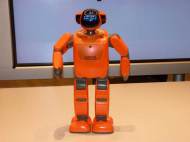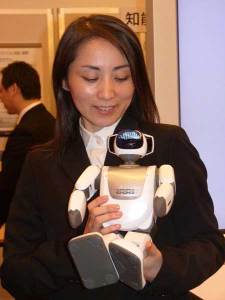Fuji Soft PALRO – a hobby robot with useful features
 Fuji Soft Inc.’s new humanoid robot platform for hobbyists and researchers has been given the name PALRO. According to its makers, the name PALRO (JP) is a combination of the words PAL (friend) and RObot. The robot combines Fuji Soft’s software with an open architecture, giving the developers a plenty of room to experiment. The sales of educational version are meant only for research and educational institutions and it will begin on March 15th, 2010. The consumer version release is planned a bit later.
Fuji Soft Inc.’s new humanoid robot platform for hobbyists and researchers has been given the name PALRO. According to its makers, the name PALRO (JP) is a combination of the words PAL (friend) and RObot. The robot combines Fuji Soft’s software with an open architecture, giving the developers a plenty of room to experiment. The sales of educational version are meant only for research and educational institutions and it will begin on March 15th, 2010. The consumer version release is planned a bit later.
PALRO robot is 39.8cm (15 inches) tall and it weighs 1.9kg (3.5 pounds). Regarding its agility, it has 2 Degrees of Freedom (DoF) in its head, 3 DoF in each of its arms and 6 DoF in each of its legs, making a total of 20 DoF. It looks a bit jittery when walking, but PALRO uses the 4 pressure sensors in each foot to balance itself in real-time. Its legs have been designed so that it can squat in order to support its own weight.
It also has a camera, 4 directional microphones, a speaker, LED arrays in its head and chest, 4 pressure sensors in each foot, 3-axis gyro sensor, an accelerometer, and an Intel Atom 1.6GHz CPU. When you combine all the elements applications, you get some advanced features the robot offers.
During the press conference, PALRO responded to verbal commands through speech recognition (“step back” and “introduce yourself”), and demonstrated its face recognition software by visually identifying three people at once. It then took a picture using its camera (the LEDs in its head lit up in the form of a camera icon) and wirelessly emailed the photo to a PC. To demonstrate its online news reading functionality, PALRO first asked which section of the news it should read before reading from that topic, gesturing as if it was flipping through a newspaper. PALRO units can also transfer applications and files to one another wirelessly.
Beside face recognition it is able to store information about certain individuals and recognize them with personal identification based on subspace. The balance of practical learning time required to identify the number of images have been commercialized. Beside answering and processing the sound and text it gets, it is able to detect the direction of the sound (hence the larger number of microphones) as well as different manners of speech (normal, loud, whisper, noise, pop, filler) in order to adapt to its surroundings.
PALRO is able to map its surroundings by pasting images taken with its camera. It also has its location awareness and route planning which helps the robot find an optimal way to the designed place. It is also able to avoid obstacles or falling down ledges. Its software can enable it even to avoid potential hazards on its route and search for alternative ones.
Its makers plan to enable users to choreograph original motion routines (and from the looks of things, LED animations) and share them online. Although it does not seem as flexible as Aldebaran Robotics’ NAO (we wrote about it as a part of our Robocup 2009 article) and it is smaller, PALRO seems to have a lot of the same software features for 1/6th of the price. It should be interesting to see if this project evolves into something larger, as well as the answer from the robot kit niche competition.










I live in Japan. Where can I buy the PALRO robot???
Thank you.
H. Honda